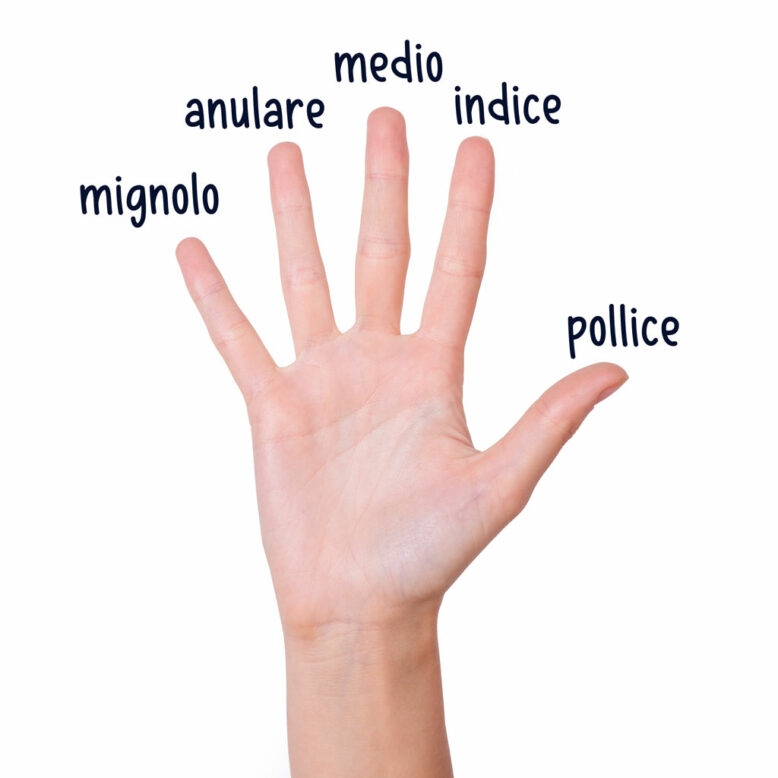Pollice, whose origin can be traced back to the Latin pollex -lĭcis, is the word for thumb in Italian.
pollice
thumb / inch

Because pollice is a masculine noun, it takes the following definite and indefinite articles:
il pollice
the thumb
un pollice
a thumb
i pollici
the thumbs
dei pollici
(some) thumbs
The thumb is the outermost digit, accompanied by l’indice (index finger), il medio (middle finger), l’anulare (ring finger) and il mignolo (pinky finger).
Mi sono tagliato il pollice mentre preparavo la cena.
I cut my thumb while I was preparing dinner.

Thumbs up is pollice all’insù in Italian, whereas thumbs down translates to pollice all’ingiù or pollice verso. These types of gestures can be traced back to the Roman Empire, when the crowd used them to determine the fate of a defeated gladiator at the end of a fight.
Did you know that…?
In one of the most famous scenes in the motion picture Gladiator, Emperor Commodus (Joaquin Phoenix) gives a thumbs down, only for the winning gladiator Maximus (Russel Crowe) to refuse to kill his defeated opponent.
However, many historians explain that the thumbs down gesture meant the opposite: to keep the sword in the scabbard and therefore spare the life of the slave. A thumbs up would mean to take out the sword and finish him. According to La Stampa, director Ridley Scott was aware of this, but decided to invert the meaning to match today’s popular culture where, generally, thumbs up is positive and thumbs down is negative.
Other historians believe that the gestures were altogether different. Some say the crowd would keep the thumb horizontal when they wanted the gladiator to die, others say that a “closed fist with a wraparound thumb” meant the gladiator could live. (Source: Wikipedia).

One of the first things I noticed about my husband when I met him was his pollice dell’autostoppista (hitchhiker’s thumb), meaning that he can bend it backwards almost 90°.
Note: Sometimes pollice and the augmentative form pollicione are used incorrectly by Italians to refer to the big toe. The correct term for this body part in Italian is alluce (or dito grosso).
Because the human thumb is roughly the length of an inch, the word pollice came to denote this specific unit of measurement. Despite being primarily an Anglo-Saxon system of measurement, it is also used in Italy, in particular to indicate the dimensions of a television screen.
Ho comprato un televisore da cinquanta pollici.
I bought a 50-inch television.
In Italian, pollice is also used figuratively to refer to a short distance or small space, especially in a negative phrases such as the following line from Moby Dick:
Era ancora là, esattamente dove l’avevo lasciato: non si era mosso di un pollice.
He was still there, exactly as I’d left him: he hadn’t moved an inch.
Idioms featuring the word ‘pollice’
Girare / Girarsi i pollici
Literal translation: to turn one’s thumbs
English meaning: to twiddle one’s thumbs
Avere il pollice verde
Literal translation: to have the green thumb
English meaning: to have a green thumb
Dare il colpo di pollice
Literal translation: to give the thumb flick
English meaning: to put the finishing touches on something
Non mollare di un pollice
Literal translation: to not give an inch
English meaning: to not give an inch
Heather Broster is a graduate with honours in linguistics from the University of Western Ontario. She is an aspiring polyglot, proficient in English and Italian, as well as Japanese, Welsh, and French to varying degrees of fluency. Originally from Toronto, Heather has resided in various countries, notably Italy for a period of six years. Her primary focus lies in the fields of language acquisition, education, and bilingual instruction.


